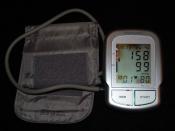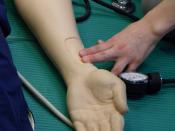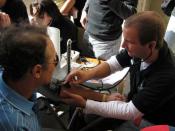Abstract
This laboratory's purpose was to show us how to determine one's blood pressure and the different factors that affect blood pressure and pulse on a person while testing one's own fitness level. After 15 seconds of exercise, my pulse had risen to 196 beats per minute. By doing this, we saw how resting required the heart to beat less because les oxygen was needed and that during exercise, more oxygen is needed, therefore the heart must pump faster. The factors on the blood pressure were a reclining pressure compared to the pressure immediately after rising. In this, I had a 10 mmHg increase. Relations between reclining and standing showed the reclining had a 6 beat per minute drop. Upon a sudden rise, the heart rate increased from 62-88 a 26 beat per minute difference.
Introduction
The human circulatory system is a collection of structures thorough which oxygen and nutrient rich blood flows to all tissues of the body for metabolism and growth, and to remove metabolic wastes.
The blood is pumped to these tissues by the heart through a circuit composed of arteries, arterioles, capillaries, venules, and veins. Oxygenated blood is pumped to the tissues from the left side of the heart, whereas deoxygenated blood is pumped to the lungs from the right side of the heart. This circuit where gas exchange takes place within the alveoli of the lung is very important and is known as the pulmonary circuit. When the body is exercised changes can take place in the circulatory system that allow more blood to pass to actively respiring muscle cells and less to non-muscular tissue. Increased heart rate, arterial pressure, body temperature, and breathing rate also occur during exercise.
Arterial blood pressure is directly dependant on the amount of blood pumped by the heart per...


